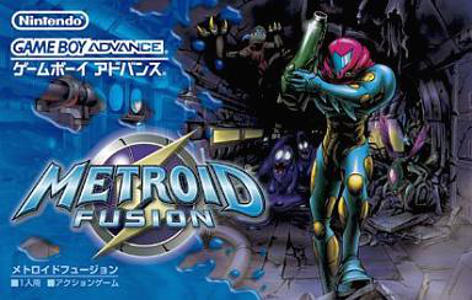Metroid Fusion (2002/2003)
[メトロイドフュージョン]

Publisher: Nintendo
Developer: Nintendo R&D1
Director: Yoshio Sakamoto
Platform: Game Boy Advance
Overview:
While investigating SR388, Samus is infested with a parasite known only as X and her life is narrowly saved by an experimental Metroid vaccine. Under the direction of an AI supervisor, she is then dispatched to a research station overrun by the X Parasite.
Gameplay:
The controls are much the same as in Super Metroid, but with some modifications to accommodate the fewer buttons on the GBA. There are a few modifications to the formula for story reasons, such as Samus' newfound vulnerability to cold that precludes her use of the Ice Beam. (You later get Ice Missiles to serve the same function, albeit with limited uses.) The ability to grip corners is especially handy before you get such modifications as the High-Jump Boots and the Space Jump. Unlike most Metroid games, progression is fairly linear, which is a sticking point with many fans. Nevertheless, the BSL is fairly expansive, so there's a lot of territory and a variety of environments to explore. Enemies hit a lot harder than in other games, which adds a little to the difficulty level to offset the hand-holding you get being directed from place to place. Also, the SA-X is a wonderful addition to the game, an enemy so much more powerful than you that you're only option is to run and hide. It makes for some heart-pumping chases.
Story/Characters:
Whereas Super Metroid told most of its story visually, this entry has a lot of talking, both conversations between Samus and the Adam AI and her elevator monologues. When the game first came out, I welcomed the more plot-heavy approach, but in light of how things went bad in The Other M, I see this more as a start of darkness for the series. I do like getting more plot and characterization, but when I LPed the game for my niece, she got really impatient during the dialog sections and it highlighted how much they disrupt the flow of the action. Fortunately, Samus' character isn't horribly derailed like it is in The Other M, and there's great potential for the story after the events of the game, but it's not something we're likely to ever see.
Graphics:
The game looks about as good as you can get on the GBA and it was one of the first titles released on the platform. As I've mentioned before, there's a good variety in the environments and you get some nice big bosses too. In some ways it's not quite as sharp as Super Metroid, but you really shouldn't be disappointed at all by the visuals. I will say that though the character art in the endings can be a bit wonky in places, overall it's my favorite look for Samus.
Music/Sound:
The music isn't nearly as good as Super Metroid, but the score does its job well enough and some of the original tracks are fairly memorable.
Conclusion:
While this game features some of the seeds that would grow into the bitter harvest of The Other M, such as excessive verbosity and linear design, it's nevertheless a worthy entry in the series. Any Metroid fan will want this in their collection, though your mileage will vary on how much some of the elements appeal to or repel you. I know that isn't the most exuberant endorsement, but it's just because I'm bitter about The Other M. It really is a good game and if you like Metroidvania-style games, you'll like this too.
Rating:
Own It
